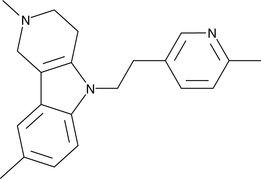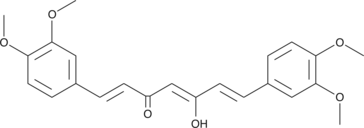Chemicals
Showing 17401–17550 of 41137 results
-
Dil is a fluorescent neuronal tracer that labels cell bodies, axons, dendrites, and dendritic spines.{49650} It has been used as an anterograde tracer to study neuronal development in vivo and as a retrograde tracer to label hippocampal neuronal connections in fixed postmortem brain tissue.{49650,49646} Dil has also been used as a long-term plasma membrane label in live cells.{49646} It displays excitation/emission maxima of 549/565 nm, respectively.{49647}
Brand:CaymanSKU:30423 - 100 mgAvailable on backorder
Dil is a fluorescent neuronal tracer that labels cell bodies, axons, dendrites, and dendritic spines.{49650} It has been used as an anterograde tracer to study neuronal development in vivo and as a retrograde tracer to label hippocampal neuronal connections in fixed postmortem brain tissue.{49650,49646} Dil has also been used as a long-term plasma membrane label in live cells.{49646} It displays excitation/emission maxima of 549/565 nm, respectively.{49647}
Brand:CaymanSKU:30423 - 25 mgAvailable on backorder
Dil is a fluorescent neuronal tracer that labels cell bodies, axons, dendrites, and dendritic spines.{49650} It has been used as an anterograde tracer to study neuronal development in vivo and as a retrograde tracer to label hippocampal neuronal connections in fixed postmortem brain tissue.{49650,49646} Dil has also been used as a long-term plasma membrane label in live cells.{49646} It displays excitation/emission maxima of 549/565 nm, respectively.{49647}
Brand:CaymanSKU:30423 - 50 mgAvailable on backorder
Dilauroyl-rac-glycerol is comprised of a mixture of C12:0 diglyceride racemates with acyl groups attached at either α, α- or α, β-positions. It has been used for the investigation of biological and physicochemical relationships of membrane glycerides.{27098,27099} It has also been employed as an industrial surfactant and a building block for synthesis of lipid derivatives.{27097}
Brand:CaymanSKU:-Out of stock
Dilauroyl-rac-glycerol is comprised of a mixture of C12:0 diglyceride racemates with acyl groups attached at either α, α- or α, β-positions. It has been used for the investigation of biological and physicochemical relationships of membrane glycerides.{27098,27099} It has also been employed as an industrial surfactant and a building block for synthesis of lipid derivatives.{27097}
Brand:CaymanSKU:-Out of stock
Dilauroyl-rac-glycerol is comprised of a mixture of C12:0 diglyceride racemates with acyl groups attached at either α, α- or α, β-positions. It has been used for the investigation of biological and physicochemical relationships of membrane glycerides.{27098,27099} It has also been employed as an industrial surfactant and a building block for synthesis of lipid derivatives.{27097}
Brand:CaymanSKU:-Out of stock
Dilazep is an inhibitor of equilibrative nucleoside transporter 1 (ENT1; IC50 = 17.5 nM).{49446} It is selective for ENT1 over ENT2 (IC50 = 8,800 nM). Dilazep (0.03 and 0.3 µM) increases adenosine-induced relaxation of, and decreases calcium-induced contractions in isolated guinea pig taenia caeci strips when used at concentrations of 1, 5, and 10 µM.{49447} Dilazep (0.2 mg/kg, i.v.) reduces heart rate and systolic, mean, and diastolic aortic pressure and increases left ventricular blood flow in anesthetized dogs.{49448} It reduces aortic platelet adhesion and aggregation in a rabbit model of aortic injury-induced thrombosis when administered intravenously at a dose of 0.1 mg/kg.{49449}
Brand:CaymanSKU:29761 - 10 mgAvailable on backorder
Dilazep is an inhibitor of equilibrative nucleoside transporter 1 (ENT1; IC50 = 17.5 nM).{49446} It is selective for ENT1 over ENT2 (IC50 = 8,800 nM). Dilazep (0.03 and 0.3 µM) increases adenosine-induced relaxation of, and decreases calcium-induced contractions in isolated guinea pig taenia caeci strips when used at concentrations of 1, 5, and 10 µM.{49447} Dilazep (0.2 mg/kg, i.v.) reduces heart rate and systolic, mean, and diastolic aortic pressure and increases left ventricular blood flow in anesthetized dogs.{49448} It reduces aortic platelet adhesion and aggregation in a rabbit model of aortic injury-induced thrombosis when administered intravenously at a dose of 0.1 mg/kg.{49449}
Brand:CaymanSKU:29761 - 25 mgAvailable on backorder
Dilazep is an inhibitor of equilibrative nucleoside transporter 1 (ENT1; IC50 = 17.5 nM).{49446} It is selective for ENT1 over ENT2 (IC50 = 8,800 nM). Dilazep (0.03 and 0.3 µM) increases adenosine-induced relaxation of, and decreases calcium-induced contractions in isolated guinea pig taenia caeci strips when used at concentrations of 1, 5, and 10 µM.{49447} Dilazep (0.2 mg/kg, i.v.) reduces heart rate and systolic, mean, and diastolic aortic pressure and increases left ventricular blood flow in anesthetized dogs.{49448} It reduces aortic platelet adhesion and aggregation in a rabbit model of aortic injury-induced thrombosis when administered intravenously at a dose of 0.1 mg/kg.{49449}
Brand:CaymanSKU:29761 - 5 mgAvailable on backorder
Dilinoelaidin is a diacylglycerol that contains the polyunsaturated 18-carbon fatty acid linoelaidic acid (Item No. 90160) at two positions.
Brand:CaymanSKU:26980 - 10 mgAvailable on backorder
Dilinoelaidin is a diacylglycerol that contains the polyunsaturated 18-carbon fatty acid linoelaidic acid (Item No. 90160) at two positions.
Brand:CaymanSKU:26980 - 100 mgAvailable on backorder
Dilinoelaidin is a diacylglycerol that contains the polyunsaturated 18-carbon fatty acid linoelaidic acid (Item No. 90160) at two positions.
Brand:CaymanSKU:26980 - 250 mgAvailable on backorder
Dilinoelaidin is a diacylglycerol that contains the polyunsaturated 18-carbon fatty acid linoelaidic acid (Item No. 90160) at two positions.
Brand:CaymanSKU:26980 - 50 mgAvailable on backorder
Diltiazem (hydrochloride) (Item No. 20079) is an analytical reference standard that is functionally categorized as a calcium channel blocker.{29898} It causes vasorelaxation and lowers blood pressure. Diltiazem is found as an adulterant in cocaine specimens.{31650} This product is intended for research and forensic applications.
Brand:CaymanSKU:20079 -Available on backorder
Diltiazem (hydrochloride) (Item No. 20079) is an analytical reference standard that is functionally categorized as a calcium channel blocker.{29898} It causes vasorelaxation and lowers blood pressure. Diltiazem is found as an adulterant in cocaine specimens.{31650} This product is intended for research and forensic applications.
Brand:CaymanSKU:20079 -Available on backorder
Dimaprit is a histamine H2 receptor agonist with a Ki value of 44 µM in guinea pig right atrium.{46616,46612} It is selective for histamine H2 over H1 and H3 receptors with relative potencies of 71, A. suum extract, which is not affected by pretreatment with mepyramine (Item No. 20978), an H1 receptor inverse agonist, or cimetidine (Item No. 18743), an H2 receptor antagonist.{46613} It stimulates gastric acid secretion in vivo in anaesthetized rats and cats with relative potencies of 19.5 and approximately 400 to 500, respectively, compared to histamine.{46614} Dimaprit inhibits 2-(2-pyridyl)ethylamine-induced bronchoconstriction in guinea pigs in a dose-dependent manner.{46615}
Brand:CaymanSKU:29418 - 100 mgAvailable on backorder
Dimaprit is a histamine H2 receptor agonist with a Ki value of 44 µM in guinea pig right atrium.{46616,46612} It is selective for histamine H2 over H1 and H3 receptors with relative potencies of 71, A. suum extract, which is not affected by pretreatment with mepyramine (Item No. 20978), an H1 receptor inverse agonist, or cimetidine (Item No. 18743), an H2 receptor antagonist.{46613} It stimulates gastric acid secretion in vivo in anaesthetized rats and cats with relative potencies of 19.5 and approximately 400 to 500, respectively, compared to histamine.{46614} Dimaprit inhibits 2-(2-pyridyl)ethylamine-induced bronchoconstriction in guinea pigs in a dose-dependent manner.{46615}
Brand:CaymanSKU:29418 - 250 mgAvailable on backorder
Dimaprit is a histamine H2 receptor agonist with a Ki value of 44 µM in guinea pig right atrium.{46616,46612} It is selective for histamine H2 over H1 and H3 receptors with relative potencies of 71, A. suum extract, which is not affected by pretreatment with mepyramine (Item No. 20978), an H1 receptor inverse agonist, or cimetidine (Item No. 18743), an H2 receptor antagonist.{46613} It stimulates gastric acid secretion in vivo in anaesthetized rats and cats with relative potencies of 19.5 and approximately 400 to 500, respectively, compared to histamine.{46614} Dimaprit inhibits 2-(2-pyridyl)ethylamine-induced bronchoconstriction in guinea pigs in a dose-dependent manner.{46615}
Brand:CaymanSKU:29418 - 50 mgAvailable on backorder
Dimebolin is a neuroprotective agent.{17760,15457,17770} It binds to histamine H1 and H2 receptors (IC50s = 3.8 and 287 nM, respectively), as well as α1A-, α1B-, α1D-, and α2A-adrenergic receptors (ARs), imidazoline I2 receptors, and the serotonin (5-HT) receptor subtypes 5-HT2A, 5-HT2C, 5-HT6, and 5-HT7 (Kis = 8-313 nM).{49510} It also inhibits NMDA-evoked currents and voltage-gated calcium channels in mouse primary striatal neurons (IC50s = 10 and 50 μM, respectively).{17760} Dimebolin (50 μM) inhibits glutamate-induced apoptosis in primary striatal neurons derived from the YAC128 transgenic mouse model of Huntington’s disease. It inhibits cell death induced by amyloid-β (25-35) (Item No. 24155) in cerebellar granule cells when used at a concentration of 25 μM.{15457} Dimebolin (1 mg/kg) inhibits decreases in two-way active avoidance reaction (TWAA) acquisition in a rat model of Alzheimer’s disease induced by 1-ethyl-1-(2-hydroxyethyl) aziridinium (AF64A).{17770}
Brand:CaymanSKU:9000556 - 1 mgAvailable on backorder
Dimebolin is a neuroprotective agent.{17760,15457,17770} It binds to histamine H1 and H2 receptors (IC50s = 3.8 and 287 nM, respectively), as well as α1A-, α1B-, α1D-, and α2A-adrenergic receptors (ARs), imidazoline I2 receptors, and the serotonin (5-HT) receptor subtypes 5-HT2A, 5-HT2C, 5-HT6, and 5-HT7 (Kis = 8-313 nM).{49510} It also inhibits NMDA-evoked currents and voltage-gated calcium channels in mouse primary striatal neurons (IC50s = 10 and 50 μM, respectively).{17760} Dimebolin (50 μM) inhibits glutamate-induced apoptosis in primary striatal neurons derived from the YAC128 transgenic mouse model of Huntington’s disease. It inhibits cell death induced by amyloid-β (25-35) (Item No. 24155) in cerebellar granule cells when used at a concentration of 25 μM.{15457} Dimebolin (1 mg/kg) inhibits decreases in two-way active avoidance reaction (TWAA) acquisition in a rat model of Alzheimer’s disease induced by 1-ethyl-1-(2-hydroxyethyl) aziridinium (AF64A).{17770}
Brand:CaymanSKU:9000556 - 10 mgAvailable on backorder
Dimebolin is a neuroprotective agent.{17760,15457,17770} It binds to histamine H1 and H2 receptors (IC50s = 3.8 and 287 nM, respectively), as well as α1A-, α1B-, α1D-, and α2A-adrenergic receptors (ARs), imidazoline I2 receptors, and the serotonin (5-HT) receptor subtypes 5-HT2A, 5-HT2C, 5-HT6, and 5-HT7 (Kis = 8-313 nM).{49510} It also inhibits NMDA-evoked currents and voltage-gated calcium channels in mouse primary striatal neurons (IC50s = 10 and 50 μM, respectively).{17760} Dimebolin (50 μM) inhibits glutamate-induced apoptosis in primary striatal neurons derived from the YAC128 transgenic mouse model of Huntington’s disease. It inhibits cell death induced by amyloid-β (25-35) (Item No. 24155) in cerebellar granule cells when used at a concentration of 25 μM.{15457} Dimebolin (1 mg/kg) inhibits decreases in two-way active avoidance reaction (TWAA) acquisition in a rat model of Alzheimer’s disease induced by 1-ethyl-1-(2-hydroxyethyl) aziridinium (AF64A).{17770}
Brand:CaymanSKU:9000556 - 25 mgAvailable on backorder
Dimebolin is a neuroprotective agent.{17760,15457,17770} It binds to histamine H1 and H2 receptors (IC50s = 3.8 and 287 nM, respectively), as well as α1A-, α1B-, α1D-, and α2A-adrenergic receptors (ARs), imidazoline I2 receptors, and the serotonin (5-HT) receptor subtypes 5-HT2A, 5-HT2C, 5-HT6, and 5-HT7 (Kis = 8-313 nM).{49510} It also inhibits NMDA-evoked currents and voltage-gated calcium channels in mouse primary striatal neurons (IC50s = 10 and 50 μM, respectively).{17760} Dimebolin (50 μM) inhibits glutamate-induced apoptosis in primary striatal neurons derived from the YAC128 transgenic mouse model of Huntington’s disease. It inhibits cell death induced by amyloid-β (25-35) (Item No. 24155) in cerebellar granule cells when used at a concentration of 25 μM.{15457} Dimebolin (1 mg/kg) inhibits decreases in two-way active avoidance reaction (TWAA) acquisition in a rat model of Alzheimer’s disease induced by 1-ethyl-1-(2-hydroxyethyl) aziridinium (AF64A).{17770}
Brand:CaymanSKU:9000556 - 5 mgAvailable on backorder
Dimebolin is a neuroprotective agent.{17760,15457,17770} It binds to histamine H1 and H2 receptors (IC50s = 3.8 and 287 nM, respectively), as well as α1A-, α1B-, α1D-, and α2A-adrenergic receptors (ARs), imidazoline I2 receptors, and the serotonin (5-HT) receptor subtypes 5-HT2A, 5-HT2C, 5-HT6, and 5-HT7 (Kis = 8-313 nM).{49510} It also inhibits NMDA-evoked currents and voltage-gated calcium channels in mouse primary striatal neurons (IC50s = 10 and 50 μM, respectively).{17760} Dimebolin (50 μM) inhibits glutamate-induced apoptosis in primary striatal neurons derived from the YAC128 transgenic mouse model of Huntington’s disease. It inhibits cell death induced by amyloid-β (25-35) (Item No. 24155) in cerebellar granule cells when used at a concentration of 25 μM.{15457} Dimebolin (1 mg/kg) inhibits decreases in two-way active avoidance reaction (TWAA) acquisition in a rat model of Alzheimer’s disease induced by 1-ethyl-1-(2-hydroxyethyl) aziridinium (AF64A).{17770}
Brand:CaymanSKU:10011349 - 1 mgAvailable on backorder
Dimebolin is a neuroprotective agent.{17760,15457,17770} It binds to histamine H1 and H2 receptors (IC50s = 3.8 and 287 nM, respectively), as well as α1A-, α1B-, α1D-, and α2A-adrenergic receptors (ARs), imidazoline I2 receptors, and the serotonin (5-HT) receptor subtypes 5-HT2A, 5-HT2C, 5-HT6, and 5-HT7 (Kis = 8-313 nM).{49510} It also inhibits NMDA-evoked currents and voltage-gated calcium channels in mouse primary striatal neurons (IC50s = 10 and 50 μM, respectively).{17760} Dimebolin (50 μM) inhibits glutamate-induced apoptosis in primary striatal neurons derived from the YAC128 transgenic mouse model of Huntington’s disease. It inhibits cell death induced by amyloid-β (25-35) (Item No. 24155) in cerebellar granule cells when used at a concentration of 25 μM.{15457} Dimebolin (1 mg/kg) inhibits decreases in two-way active avoidance reaction (TWAA) acquisition in a rat model of Alzheimer’s disease induced by 1-ethyl-1-(2-hydroxyethyl) aziridinium (AF64A).{17770}
Brand:CaymanSKU:10011349 - 10 mgAvailable on backorder
Dimebolin is a neuroprotective agent.{17760,15457,17770} It binds to histamine H1 and H2 receptors (IC50s = 3.8 and 287 nM, respectively), as well as α1A-, α1B-, α1D-, and α2A-adrenergic receptors (ARs), imidazoline I2 receptors, and the serotonin (5-HT) receptor subtypes 5-HT2A, 5-HT2C, 5-HT6, and 5-HT7 (Kis = 8-313 nM).{49510} It also inhibits NMDA-evoked currents and voltage-gated calcium channels in mouse primary striatal neurons (IC50s = 10 and 50 μM, respectively).{17760} Dimebolin (50 μM) inhibits glutamate-induced apoptosis in primary striatal neurons derived from the YAC128 transgenic mouse model of Huntington’s disease. It inhibits cell death induced by amyloid-β (25-35) (Item No. 24155) in cerebellar granule cells when used at a concentration of 25 μM.{15457} Dimebolin (1 mg/kg) inhibits decreases in two-way active avoidance reaction (TWAA) acquisition in a rat model of Alzheimer’s disease induced by 1-ethyl-1-(2-hydroxyethyl) aziridinium (AF64A).{17770}
Brand:CaymanSKU:10011349 - 25 mgAvailable on backorder
Dimebolin is a neuroprotective agent.{17760,15457,17770} It binds to histamine H1 and H2 receptors (IC50s = 3.8 and 287 nM, respectively), as well as α1A-, α1B-, α1D-, and α2A-adrenergic receptors (ARs), imidazoline I2 receptors, and the serotonin (5-HT) receptor subtypes 5-HT2A, 5-HT2C, 5-HT6, and 5-HT7 (Kis = 8-313 nM).{49510} It also inhibits NMDA-evoked currents and voltage-gated calcium channels in mouse primary striatal neurons (IC50s = 10 and 50 μM, respectively).{17760} Dimebolin (50 μM) inhibits glutamate-induced apoptosis in primary striatal neurons derived from the YAC128 transgenic mouse model of Huntington’s disease. It inhibits cell death induced by amyloid-β (25-35) (Item No. 24155) in cerebellar granule cells when used at a concentration of 25 μM.{15457} Dimebolin (1 mg/kg) inhibits decreases in two-way active avoidance reaction (TWAA) acquisition in a rat model of Alzheimer’s disease induced by 1-ethyl-1-(2-hydroxyethyl) aziridinium (AF64A).{17770}
Brand:CaymanSKU:10011349 - 5 mgAvailable on backorder
Dimethoate is an organophosphate pesticide.{42384} It is acaricidal against Kanzawa spider mites (LC50 = 7 ppm in an aqueous suspension) and inhibits purified Kanzawa spider mite acetylcholinesterase (AChE; IC50 = 3.3-5.2 nM). Dimethoate (50-200 μM) reduces motility and viability and induces abnormal morphology of rat sperm.{42385} It also increases production of malondialdehyde (MDA) and reduces superoxide dismutase (SOD), catalase (CAT), and glutathione peroxidase (Gpx) activities in rat epididymal sperm. In vivo, dimethoate (28 mg/kg per day) decreases sperm count, motility, and viability and increases the percentage of morphologically abnormal sperm in rats.{42386} Dimethoate also induces formation of carcinomas in the adrenal, thyroid, and pituitary glands of male and female rats as well as testicular atrophy, chronic renal disease, polyarteritis, and parathyroid hyperplasia in male rats.{42387}
Brand:CaymanSKU:24246 - 100 mgAvailable on backorder
Dimethoate is an organophosphate pesticide.{42384} It is acaricidal against Kanzawa spider mites (LC50 = 7 ppm in an aqueous suspension) and inhibits purified Kanzawa spider mite acetylcholinesterase (AChE; IC50 = 3.3-5.2 nM). Dimethoate (50-200 μM) reduces motility and viability and induces abnormal morphology of rat sperm.{42385} It also increases production of malondialdehyde (MDA) and reduces superoxide dismutase (SOD), catalase (CAT), and glutathione peroxidase (Gpx) activities in rat epididymal sperm. In vivo, dimethoate (28 mg/kg per day) decreases sperm count, motility, and viability and increases the percentage of morphologically abnormal sperm in rats.{42386} Dimethoate also induces formation of carcinomas in the adrenal, thyroid, and pituitary glands of male and female rats as well as testicular atrophy, chronic renal disease, polyarteritis, and parathyroid hyperplasia in male rats.{42387}
Brand:CaymanSKU:24246 - 50 mgAvailable on backorder
Dimethocaine is a local anesthetic that, because of its similarity in action to cocaine, has potential for abuse. This compound completely inhibits dopamine uptake in rat striatal synaptosomes with an IC50 value of 1.2 µM comparable to that of cocaine (IC50 = 0.7 µM).{24176} As a result, dimethocaine dose-dependently substitutes for cocaine in drug discrimination tests in rats and rhesus monkeys.{24175,23694} This product is intended for forensic and research purposes.
Brand:CaymanSKU:11159 - 1 mgAvailable on backorder
Dimethocaine is a local anesthetic that, because of its similarity in action to cocaine, has potential for abuse. This compound completely inhibits dopamine uptake in rat striatal synaptosomes with an IC50 value of 1.2 µM comparable to that of cocaine (IC50 = 0.7 µM).{24176} As a result, dimethocaine dose-dependently substitutes for cocaine in drug discrimination tests in rats and rhesus monkeys.{24175,23694} This product is intended for forensic and research purposes.
Brand:CaymanSKU:11159 - 10 mgAvailable on backorder
Dimethocaine is a local anesthetic that, because of its similarity in action to cocaine, has potential for abuse. This compound completely inhibits dopamine uptake in rat striatal synaptosomes with an IC50 value of 1.2 µM comparable to that of cocaine (IC50 = 0.7 µM).{24176} As a result, dimethocaine dose-dependently substitutes for cocaine in drug discrimination tests in rats and rhesus monkeys.{24175,23694} This product is intended for forensic and research purposes.
Brand:CaymanSKU:11159 - 5 mgAvailable on backorder
Dimethomorph is a morpholine fungicide that inhibits fungal cell wall formation.{43298} It inhibits mycelial growth of the oomycete fungi P. citrophthora, P. parasitica, P. capsici, and P. infestans (EC50s = 0.14, 0.38, C. vulgaris or S. obliquus in vitro (EC50s = 47.46 and 44.87 µg/ml, respectively).{43300,43133,43299} It inhibits androgen receptor (AR) activity in a reporter assay in MDA-kb2 human breast cancer cells but not in a yeast antiandrogen screen (IC20s = 0.263 and 38.5 µM, respectively).{42005} It is not toxic to rats (LD50 = 3,900 mg/kg) or goldfish (C. auratus; LC50 = >32 µg/ml).{43299,43298}
Brand:CaymanSKU:24247 - 100 mgAvailable on backorder
Dimethomorph is a morpholine fungicide that inhibits fungal cell wall formation.{43298} It inhibits mycelial growth of the oomycete fungi P. citrophthora, P. parasitica, P. capsici, and P. infestans (EC50s = 0.14, 0.38, C. vulgaris or S. obliquus in vitro (EC50s = 47.46 and 44.87 µg/ml, respectively).{43300,43133,43299} It inhibits androgen receptor (AR) activity in a reporter assay in MDA-kb2 human breast cancer cells but not in a yeast antiandrogen screen (IC20s = 0.263 and 38.5 µM, respectively).{42005} It is not toxic to rats (LD50 = 3,900 mg/kg) or goldfish (C. auratus; LC50 = >32 µg/ml).{43299,43298}
Brand:CaymanSKU:24247 - 50 mgAvailable on backorder
Dimethoxycurcumin is a derivative of curcumin (Item No. 81025) that has anti-inflammatory and antioxidant activities.{53899,53900,53901} It inhibits mitogen-induced proliferation of CD4+ T cells, CD8+ T cells, and B cells, as well as secretion of IL-2, IL-4, IL-6, and IFN-γ induced by concanavalin A (Item No. 14951) in isolated human lymphocytes when used at concentrations ranging from 1 to 10 µM.{53899} Dimethoxycurcumin (1-10 µM) inhibits LPS-induced nitric oxide (NO) production and expression of inducible nitric oxide synthase (iNOS) in RAW 264.7 cells.{53900} It inhibits hemolysis of isolated human red blood cells (RBCs) induced by AAPH (Item No. 82235) when used at a concentration of 10 µM.{53901}
Brand:CaymanSKU:10009986 - 1 mgAvailable on backorder
Dimethoxycurcumin is a derivative of curcumin (Item No. 81025) that has anti-inflammatory and antioxidant activities.{53899,53900,53901} It inhibits mitogen-induced proliferation of CD4+ T cells, CD8+ T cells, and B cells, as well as secretion of IL-2, IL-4, IL-6, and IFN-γ induced by concanavalin A (Item No. 14951) in isolated human lymphocytes when used at concentrations ranging from 1 to 10 µM.{53899} Dimethoxycurcumin (1-10 µM) inhibits LPS-induced nitric oxide (NO) production and expression of inducible nitric oxide synthase (iNOS) in RAW 264.7 cells.{53900} It inhibits hemolysis of isolated human red blood cells (RBCs) induced by AAPH (Item No. 82235) when used at a concentration of 10 µM.{53901}
Brand:CaymanSKU:10009986 - 10 mgAvailable on backorder
Dimethoxycurcumin is a derivative of curcumin (Item No. 81025) that has anti-inflammatory and antioxidant activities.{53899,53900,53901} It inhibits mitogen-induced proliferation of CD4+ T cells, CD8+ T cells, and B cells, as well as secretion of IL-2, IL-4, IL-6, and IFN-γ induced by concanavalin A (Item No. 14951) in isolated human lymphocytes when used at concentrations ranging from 1 to 10 µM.{53899} Dimethoxycurcumin (1-10 µM) inhibits LPS-induced nitric oxide (NO) production and expression of inducible nitric oxide synthase (iNOS) in RAW 264.7 cells.{53900} It inhibits hemolysis of isolated human red blood cells (RBCs) induced by AAPH (Item No. 82235) when used at a concentration of 10 µM.{53901}
Brand:CaymanSKU:10009986 - 5 mgAvailable on backorder
Dimethyl biphenyl-4,4′-dicarboxylate is a planar biphenyldicarboxylic acid ester used as a hepatoprotectant in the treatment of chronic hepatitis.{29026} At 250 µg/ml, it has been shown to stimulate JAK/STAT signaling and to induce the expression of interferon-α stimulated genes in a HepG2 cell line.{29026}
Brand:CaymanSKU:-Available on backorder
Dimethyl biphenyl-4,4′-dicarboxylate is a planar biphenyldicarboxylic acid ester used as a hepatoprotectant in the treatment of chronic hepatitis.{29026} At 250 µg/ml, it has been shown to stimulate JAK/STAT signaling and to induce the expression of interferon-α stimulated genes in a HepG2 cell line.{29026}
Brand:CaymanSKU:-Available on backorder
Dimethyl biphenyl-4,4′-dicarboxylate is a planar biphenyldicarboxylic acid ester used as a hepatoprotectant in the treatment of chronic hepatitis.{29026} At 250 µg/ml, it has been shown to stimulate JAK/STAT signaling and to induce the expression of interferon-α stimulated genes in a HepG2 cell line.{29026}
Brand:CaymanSKU:-Available on backorder
Dimethyl biphenyl-4,4′-dicarboxylate is a planar biphenyldicarboxylic acid ester used as a hepatoprotectant in the treatment of chronic hepatitis.{29026} At 250 µg/ml, it has been shown to stimulate JAK/STAT signaling and to induce the expression of interferon-α stimulated genes in a HepG2 cell line.{29026}
Brand:CaymanSKU:-Available on backorder
While extracellular glutamic acid is an excitatory neurotransmitter, intracellular glutamic acid is an amino acid that serves numerous metabolic roles.{24138} Dimethyl DL-glutamate is a cell-permeant glutamic acid derivative that enhances insulin release in response to glucose in isolated islets and in animal models of diabetes.{30318,30315} It also potentiates the insulinotropic potential of glyburide (Item No. 15009) and glucagon-like peptide 1.{30318,30315} Dimethyl DL-glutamate is used as a cell-permeable form of glutamate in studies of glutamate action in β-cells.{30316,30320} However, it can be cytotoxic to myeloid cells and act as an antagonist of glutamate-mediated neurosignaling.{30319,30317}
Brand:CaymanSKU:-Available on backorder
While extracellular glutamic acid is an excitatory neurotransmitter, intracellular glutamic acid is an amino acid that serves numerous metabolic roles.{24138} Dimethyl DL-glutamate is a cell-permeant glutamic acid derivative that enhances insulin release in response to glucose in isolated islets and in animal models of diabetes.{30318,30315} It also potentiates the insulinotropic potential of glyburide (Item No. 15009) and glucagon-like peptide 1.{30318,30315} Dimethyl DL-glutamate is used as a cell-permeable form of glutamate in studies of glutamate action in β-cells.{30316,30320} However, it can be cytotoxic to myeloid cells and act as an antagonist of glutamate-mediated neurosignaling.{30319,30317}
Brand:CaymanSKU:-Available on backorder
While extracellular glutamic acid is an excitatory neurotransmitter, intracellular glutamic acid is an amino acid that serves numerous metabolic roles.{24138} Dimethyl DL-glutamate is a cell-permeant glutamic acid derivative that enhances insulin release in response to glucose in isolated islets and in animal models of diabetes.{30318,30315} It also potentiates the insulinotropic potential of glyburide (Item No. 15009) and glucagon-like peptide 1.{30318,30315} Dimethyl DL-glutamate is used as a cell-permeable form of glutamate in studies of glutamate action in β-cells.{30316,30320} However, it can be cytotoxic to myeloid cells and act as an antagonist of glutamate-mediated neurosignaling.{30319,30317}
Brand:CaymanSKU:-Available on backorder
While extracellular glutamic acid is an excitatory neurotransmitter, intracellular glutamic acid is an amino acid that serves numerous metabolic roles.{24138} Dimethyl DL-glutamate is a cell-permeant glutamic acid derivative that enhances insulin release in response to glucose in isolated islets and in animal models of diabetes.{30318,30315} It also potentiates the insulinotropic potential of glyburide (Item No. 15009) and glucagon-like peptide 1.{30318,30315} Dimethyl DL-glutamate is used as a cell-permeable form of glutamate in studies of glutamate action in β-cells.{30316,30320} However, it can be cytotoxic to myeloid cells and act as an antagonist of glutamate-mediated neurosignaling.{30319,30317}
Brand:CaymanSKU:-Available on backorder
Dimethyl fumarate is a lipophilic electrophile that has profound effects on oxidative and immunological pathways.{23442} It rapidly interacts in a Michael addition reaction with glutathione or is metabolized to monomethyl fumarate.{23442} Dimethyl fumarate at low micromolar levels activates the nuclear factor erythroid 2-related factor 2 (Nrf2), resulting in an antioxidant response featuring heme oxygenase-1 expression and increased glutathione levels.{23442} It also suppresses the expression of pro-inflammatory cytokines and inhibits angiogenesis.{23440,23439} Through these actions dimethyl fumarate alters the course of psoriasis and may reduce inflammation related to multiple sclerosis.{23440,23441}
Brand:CaymanSKU:-Dimethyl fumarate is a lipophilic electrophile that has profound effects on oxidative and immunological pathways.{23442} It rapidly interacts in a Michael addition reaction with glutathione or is metabolized to monomethyl fumarate.{23442} Dimethyl fumarate at low micromolar levels activates the nuclear factor erythroid 2-related factor 2 (Nrf2), resulting in an antioxidant response featuring heme oxygenase-1 expression and increased glutathione levels.{23442} It also suppresses the expression of pro-inflammatory cytokines and inhibits angiogenesis.{23440,23439} Through these actions dimethyl fumarate alters the course of psoriasis and may reduce inflammation related to multiple sclerosis.{23440,23441}
Brand:CaymanSKU:-Dimethyl fumarate is a lipophilic electrophile that has profound effects on oxidative and immunological pathways.{23442} It rapidly interacts in a Michael addition reaction with glutathione or is metabolized to monomethyl fumarate.{23442} Dimethyl fumarate at low micromolar levels activates the nuclear factor erythroid 2-related factor 2 (Nrf2), resulting in an antioxidant response featuring heme oxygenase-1 expression and increased glutathione levels.{23442} It also suppresses the expression of pro-inflammatory cytokines and inhibits angiogenesis.{23440,23439} Through these actions dimethyl fumarate alters the course of psoriasis and may reduce inflammation related to multiple sclerosis.{23440,23441}
Brand:CaymanSKU:-Dimethyl fumarate is a lipophilic electrophile that has profound effects on oxidative and immunological pathways.{23442} It rapidly interacts in a Michael addition reaction with glutathione or is metabolized to monomethyl fumarate.{23442} Dimethyl fumarate at low micromolar levels activates the nuclear factor erythroid 2-related factor 2 (Nrf2), resulting in an antioxidant response featuring heme oxygenase-1 expression and increased glutathione levels.{23442} It also suppresses the expression of pro-inflammatory cytokines and inhibits angiogenesis.{23440,23439} Through these actions dimethyl fumarate alters the course of psoriasis and may reduce inflammation related to multiple sclerosis.{23440,23441}
Brand:CaymanSKU:-Dimethyl sulfone (Item No. 20131) is an analytical reference standard that is structurally categorized as an organic sulfur derivative. It is a natural oxidized form of DMSO and has been described to have anti-inflammatory and analgesic properties.{31808} Dimethyl sulfone is commonly found as an adulterant in methamphetamine samples.{31809,31810} This product is intended for research and forensic applications.
Brand:CaymanSKU:20131 -Available on backorder
Dimethyl sulfone (Item No. 20131) is an analytical reference standard that is structurally categorized as an organic sulfur derivative. It is a natural oxidized form of DMSO and has been described to have anti-inflammatory and analgesic properties.{31808} Dimethyl sulfone is commonly found as an adulterant in methamphetamine samples.{31809,31810} This product is intended for research and forensic applications.
Brand:CaymanSKU:20131 -Available on backorder
Dimethyl-W84 is a selective allosteric modulator of the M2 muscarinic acetylcholine receptor.{30736,30737} It hinders the dissociation of the orthosteric antagonist N-methylscopolamine from the M2 receptor with an EC50 value of 3 nM.{30736,30737}
Brand:CaymanSKU:-Out of stock
Dimethylamino parthenolide (DMAPT) is a water-soluble parthenolide (Item No. 70080) analog developed for improved bioavailability.{31981} It has been shown to eradicate primary leukemia stem cells and to inhibit the proliferation and metastasis of various tumor cells by targeting NF-κB, generating reactive oxygen species, and decreasing metalloproteinases 2 and 9 as well as VEGF.{31981,31980,31982}
Brand:CaymanSKU:20436 -Available on backorder
Dimethylamino parthenolide (DMAPT) is a water-soluble parthenolide (Item No. 70080) analog developed for improved bioavailability.{31981} It has been shown to eradicate primary leukemia stem cells and to inhibit the proliferation and metastasis of various tumor cells by targeting NF-κB, generating reactive oxygen species, and decreasing metalloproteinases 2 and 9 as well as VEGF.{31981,31980,31982}
Brand:CaymanSKU:20436 -Available on backorder
Dimethylcurcumin is a selective enhancer of androgen receptor (AR) degradation. By disrupting the interaction between AR and its coregulators, dimethylcurcumin directs the degradation of AR and reduces signaling through this receptor both in cultured cells and in animals.{34108,34109,34112} In this way, dimethylcurcumin suppresses the growth of hepatocellular carcinoma (HCC) cells both in culture and in mice.{34109} Dimethylcurcumin can be used to elucidate the consequences of signaling through AR in various cell types.{34108,34110,34111}
Brand:CaymanSKU:10008187 - 1 mgAvailable on backorder
Dimethylcurcumin is a selective enhancer of androgen receptor (AR) degradation. By disrupting the interaction between AR and its coregulators, dimethylcurcumin directs the degradation of AR and reduces signaling through this receptor both in cultured cells and in animals.{34108,34109,34112} In this way, dimethylcurcumin suppresses the growth of hepatocellular carcinoma (HCC) cells both in culture and in mice.{34109} Dimethylcurcumin can be used to elucidate the consequences of signaling through AR in various cell types.{34108,34110,34111}
Brand:CaymanSKU:10008187 - 10 mgAvailable on backorder
Dimethylcurcumin is a selective enhancer of androgen receptor (AR) degradation. By disrupting the interaction between AR and its coregulators, dimethylcurcumin directs the degradation of AR and reduces signaling through this receptor both in cultured cells and in animals.{34108,34109,34112} In this way, dimethylcurcumin suppresses the growth of hepatocellular carcinoma (HCC) cells both in culture and in mice.{34109} Dimethylcurcumin can be used to elucidate the consequences of signaling through AR in various cell types.{34108,34110,34111}
Brand:CaymanSKU:10008187 - 25 mgAvailable on backorder
Dimethylcurcumin is a selective enhancer of androgen receptor (AR) degradation. By disrupting the interaction between AR and its coregulators, dimethylcurcumin directs the degradation of AR and reduces signaling through this receptor both in cultured cells and in animals.{34108,34109,34112} In this way, dimethylcurcumin suppresses the growth of hepatocellular carcinoma (HCC) cells both in culture and in mice.{34109} Dimethylcurcumin can be used to elucidate the consequences of signaling through AR in various cell types.{34108,34110,34111}
Brand:CaymanSKU:10008187 - 5 mgAvailable on backorder
Dimethyldioctadecylammonium (DDA) is a cationic amphipathic lipid.{36982,36983} DDA liposomes containing an Ag85B-ESAT-6 antigen induce antigen deposition at an intramuscular or subcutaneous injection site in mice, increasing immune cell exposure to the antigen.{36984} In a guinea pig model of M. tuberculosis infection, spleen bacterial load is reduced and lung and spleen lesion numbers are decreased when the mycobacterial lipid antigens Ac2SGL and PIM2 are administered in liposomes comprised of DDA and a synthetic analog of the mycobacterial cord factor trehalose 6,6-dibehenate (TDB).{36983} DDA has also been used in the study of lipid bilayer dynamics.{36985}
Brand:CaymanSKU:26120 - 10 gAvailable on backorder
Dimethyldioctadecylammonium (DDA) is a cationic amphipathic lipid.{36982,36983} DDA liposomes containing an Ag85B-ESAT-6 antigen induce antigen deposition at an intramuscular or subcutaneous injection site in mice, increasing immune cell exposure to the antigen.{36984} In a guinea pig model of M. tuberculosis infection, spleen bacterial load is reduced and lung and spleen lesion numbers are decreased when the mycobacterial lipid antigens Ac2SGL and PIM2 are administered in liposomes comprised of DDA and a synthetic analog of the mycobacterial cord factor trehalose 6,6-dibehenate (TDB).{36983} DDA has also been used in the study of lipid bilayer dynamics.{36985}
Brand:CaymanSKU:26120 - 25 gAvailable on backorder
Dimethyldioctadecylammonium (DDA) is a cationic amphipathic lipid.{36982,36983} DDA liposomes containing an Ag85B-ESAT-6 antigen induce antigen deposition at an intramuscular or subcutaneous injection site in mice, increasing immune cell exposure to the antigen.{36984} In a guinea pig model of M. tuberculosis infection, spleen bacterial load is reduced and lung and spleen lesion numbers are decreased when the mycobacterial lipid antigens Ac2SGL and PIM2 are administered in liposomes comprised of DDA and a synthetic analog of the mycobacterial cord factor trehalose 6,6-dibehenate (TDB).{36983} DDA has also been used in the study of lipid bilayer dynamics.{36985}
Brand:CaymanSKU:26120 - 5 gAvailable on backorder
Dimethyldioctadecylammonium (DDA) is a cationic amphipathic lipid.{36982,36983} DDA liposomes containing an Ag85B-ESAT-6 antigen induce antigen deposition at an intramuscular or subcutaneous injection site in mice, increasing immune cell exposure to the antigen.{36984} In a guinea pig model of M. tuberculosis infection, spleen bacterial load is reduced and lung and spleen lesion numbers are decreased when the mycobacterial lipid antigens Ac2SGL and PIM2 are administered in liposomes comprised of DDA and a synthetic analog of the mycobacterial cord factor trehalose 6,6-dibehenate (TDB).{36983} DDA has also been used in the study of lipid bilayer dynamics.{36985}
Brand:CaymanSKU:26120 - 50 gAvailable on backorder
Dimethylenastron is an inhibitor of the mitotic kinesin Eg5 (IC50 = 200 nM in an ATPase assay).{40431} It is selective for Eg5 over other kinesin subfamilies from four different organisms. Dimethylenastron induces accumulation of HeLa cells in the G2/M phase (75% at a concentration of 1 μM). It inhibits spindle formation and induces radial arrangement of chromosomes in Xenopus oocytes. Dimethylenastron inhibits migration and growth of PANC-1 pancreatic cancer cells in a concentration-dependent manner.{40432} Dimethylenastron also inhibits angiogenesis and induces severe circulation defects in zebrafish embryos.{40433}
Brand:CaymanSKU:22357 -Out of stock
Dimethylenastron is an inhibitor of the mitotic kinesin Eg5 (IC50 = 200 nM in an ATPase assay).{40431} It is selective for Eg5 over other kinesin subfamilies from four different organisms. Dimethylenastron induces accumulation of HeLa cells in the G2/M phase (75% at a concentration of 1 μM). It inhibits spindle formation and induces radial arrangement of chromosomes in Xenopus oocytes. Dimethylenastron inhibits migration and growth of PANC-1 pancreatic cancer cells in a concentration-dependent manner.{40432} Dimethylenastron also inhibits angiogenesis and induces severe circulation defects in zebrafish embryos.{40433}
Brand:CaymanSKU:22357 -Out of stock
Dimethylenastron is an inhibitor of the mitotic kinesin Eg5 (IC50 = 200 nM in an ATPase assay).{40431} It is selective for Eg5 over other kinesin subfamilies from four different organisms. Dimethylenastron induces accumulation of HeLa cells in the G2/M phase (75% at a concentration of 1 μM). It inhibits spindle formation and induces radial arrangement of chromosomes in Xenopus oocytes. Dimethylenastron inhibits migration and growth of PANC-1 pancreatic cancer cells in a concentration-dependent manner.{40432} Dimethylenastron also inhibits angiogenesis and induces severe circulation defects in zebrafish embryos.{40433}
Brand:CaymanSKU:22357 -Out of stock
Dimethylenastron is an inhibitor of the mitotic kinesin Eg5 (IC50 = 200 nM in an ATPase assay).{40431} It is selective for Eg5 over other kinesin subfamilies from four different organisms. Dimethylenastron induces accumulation of HeLa cells in the G2/M phase (75% at a concentration of 1 μM). It inhibits spindle formation and induces radial arrangement of chromosomes in Xenopus oocytes. Dimethylenastron inhibits migration and growth of PANC-1 pancreatic cancer cells in a concentration-dependent manner.{40432} Dimethylenastron also inhibits angiogenesis and induces severe circulation defects in zebrafish embryos.{40433}
Brand:CaymanSKU:22357 -Out of stock
Dimethylsildenafil is a derivative of the phosphodiesterase 5 (PDE5) inhibitor sildenafil (Item No. 10008671).{56087}
Brand:CaymanSKU:30899 - 1 mgAvailable on backorder
Dimetridazole-d3 is intended for use as an internal standard for the quantification of dimetridazole by GC- or LC-MS. Dimetridazole is a nitroimidazole antiprotozoal agent that has activity against Bacteroides species (mean MIC = 2.7 μM).{26702} It is also active against 16 clinical isolates of B. fragilis (MICs = 0.28-2.82 μg/ml). Formulations containing dimetridazole have been used to treat Giardia infections in livestock.
Brand:CaymanSKU:27841 - 1 mgAvailable on backorder
Dimetridazole-d3 is intended for use as an internal standard for the quantification of dimetridazole by GC- or LC-MS. Dimetridazole is a nitroimidazole antiprotozoal agent that has activity against Bacteroides species (mean MIC = 2.7 μM).{26702} It is also active against 16 clinical isolates of B. fragilis (MICs = 0.28-2.82 μg/ml). Formulations containing dimetridazole have been used to treat Giardia infections in livestock.
Brand:CaymanSKU:27841 - 5 mgAvailable on backorder
Dimetridazole-d3 is intended for use as an internal standard for the quantification of dimetridazole by GC- or LC-MS. Dimetridazole is a nitroimidazole antiprotozoal agent that has activity against Bacteroides species (mean MIC = 2.7 μM).{26702} It is also active against 16 clinical isolates of B. fragilis (MICs = 0.28-2.82 μg/ml). Formulations containing dimetridazole have been used to treat Giardia infections in livestock.
Brand:CaymanSKU:27841 - 500 µgAvailable on backorder
Diminazene is a diamidine that is cytotoxic to protozoa, including Trypanosoma, Babesia, and Cytauxzoon.{30410,30407} Diamidines, including diminazene, affect a variety of enzymes and modulate interactions between nucleic acids and proteins.{30408} Diminazene inhibits diamine oxidase with a Ki value of 13 nM.{30408} In Trypanosoma, transport proteins are important in the effectiveness of diminazene.{30411} In rats and in vitro, diminazene enhances the enzymatic activity of angiotensin-converting enzyme 2.{30412}
Brand:CaymanSKU:-Available on backorder
Diminazene is a diamidine that is cytotoxic to protozoa, including Trypanosoma, Babesia, and Cytauxzoon.{30410,30407} Diamidines, including diminazene, affect a variety of enzymes and modulate interactions between nucleic acids and proteins.{30408} Diminazene inhibits diamine oxidase with a Ki value of 13 nM.{30408} In Trypanosoma, transport proteins are important in the effectiveness of diminazene.{30411} In rats and in vitro, diminazene enhances the enzymatic activity of angiotensin-converting enzyme 2.{30412}
Brand:CaymanSKU:-Available on backorder
Diminazene is a diamidine that is cytotoxic to protozoa, including Trypanosoma, Babesia, and Cytauxzoon.{30410,30407} Diamidines, including diminazene, affect a variety of enzymes and modulate interactions between nucleic acids and proteins.{30408} Diminazene inhibits diamine oxidase with a Ki value of 13 nM.{30408} In Trypanosoma, transport proteins are important in the effectiveness of diminazene.{30411} In rats and in vitro, diminazene enhances the enzymatic activity of angiotensin-converting enzyme 2.{30412}
Brand:CaymanSKU:-Available on backorder
Diminutol is a cell-permeable purine derivative that inhibits the NADP-dependent oxidoreductase, NQO1 (Ki = 1.72 µM), to destabilize microtubules and disrupt mitosis.{29458} At 50 µM, it directly affects tubulin polymerization in Xenopus egg extracts without interfering with the activity of Cdk1, DNA replication, or actin polymerization.{29458}
Brand:CaymanSKU:-Available on backorder
Diminutol is a cell-permeable purine derivative that inhibits the NADP-dependent oxidoreductase, NQO1 (Ki = 1.72 µM), to destabilize microtubules and disrupt mitosis.{29458} At 50 µM, it directly affects tubulin polymerization in Xenopus egg extracts without interfering with the activity of Cdk1, DNA replication, or actin polymerization.{29458}
Brand:CaymanSKU:-Available on backorder
Diminutol is a cell-permeable purine derivative that inhibits the NADP-dependent oxidoreductase, NQO1 (Ki = 1.72 µM), to destabilize microtubules and disrupt mitosis.{29458} At 50 µM, it directly affects tubulin polymerization in Xenopus egg extracts without interfering with the activity of Cdk1, DNA replication, or actin polymerization.{29458}
Brand:CaymanSKU:-Available on backorder
Diminutol is a cell-permeable purine derivative that inhibits the NADP-dependent oxidoreductase, NQO1 (Ki = 1.72 µM), to destabilize microtubules and disrupt mitosis.{29458} At 50 µM, it directly affects tubulin polymerization in Xenopus egg extracts without interfering with the activity of Cdk1, DNA replication, or actin polymerization.{29458}
Brand:CaymanSKU:-Available on backorder
Brand:CaymanSKU:26949 - 100 mgAvailable on backorder
Brand:CaymanSKU:26949 - 250 mgAvailable on backorder
Brand:CaymanSKU:26949 - 500 mgAvailable on backorder
Dimyristolein is a diacylglycerol that contains the monounsaturated 14-carbon fatty acid myristoleic acid (Item No. 9002461) at two positions.
Brand:CaymanSKU:26977 - 1 mgAvailable on backorder
Dimyristolein is a diacylglycerol that contains the monounsaturated 14-carbon fatty acid myristoleic acid (Item No. 9002461) at two positions.
Brand:CaymanSKU:26977 - 10 mgAvailable on backorder


























